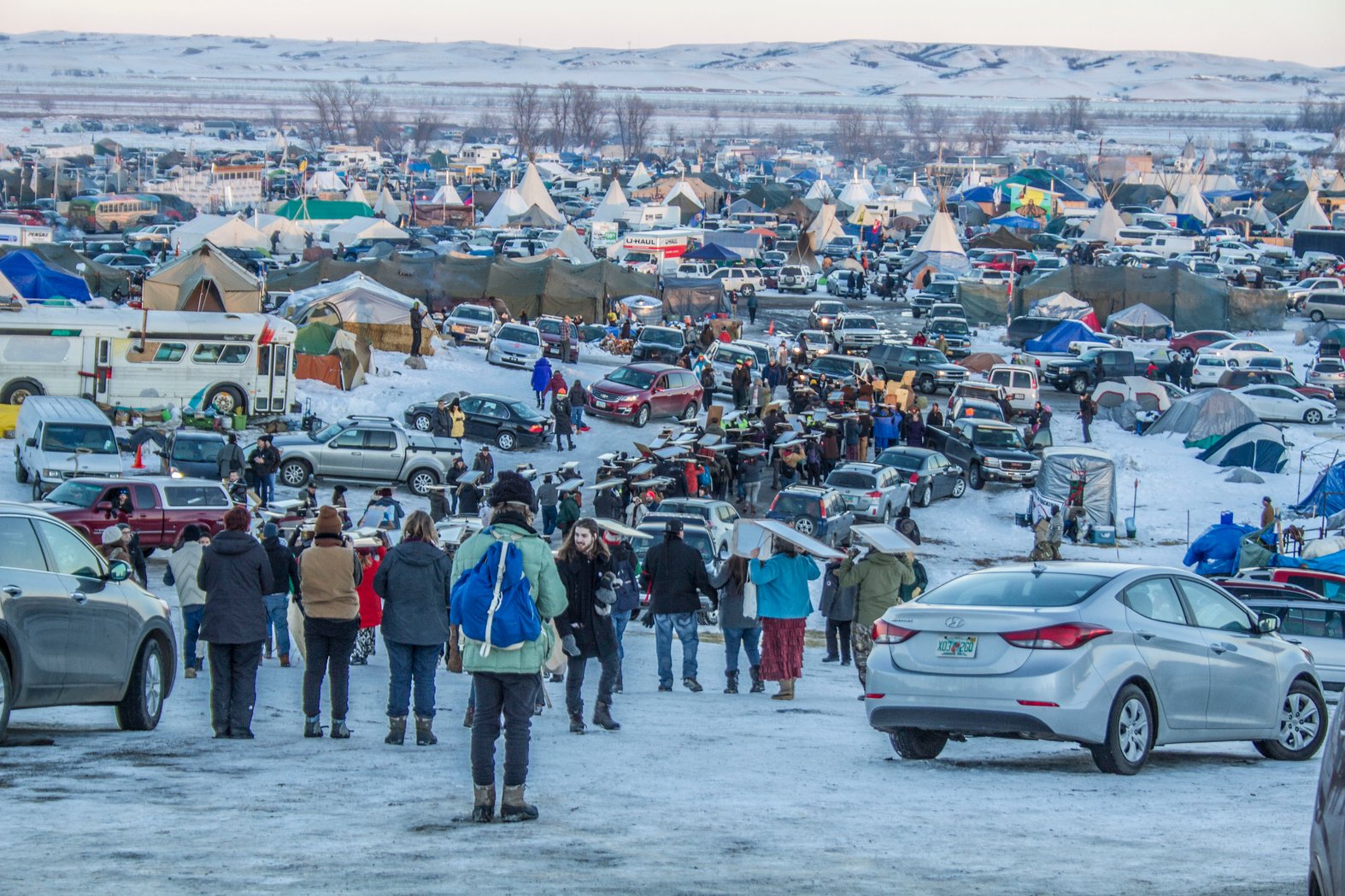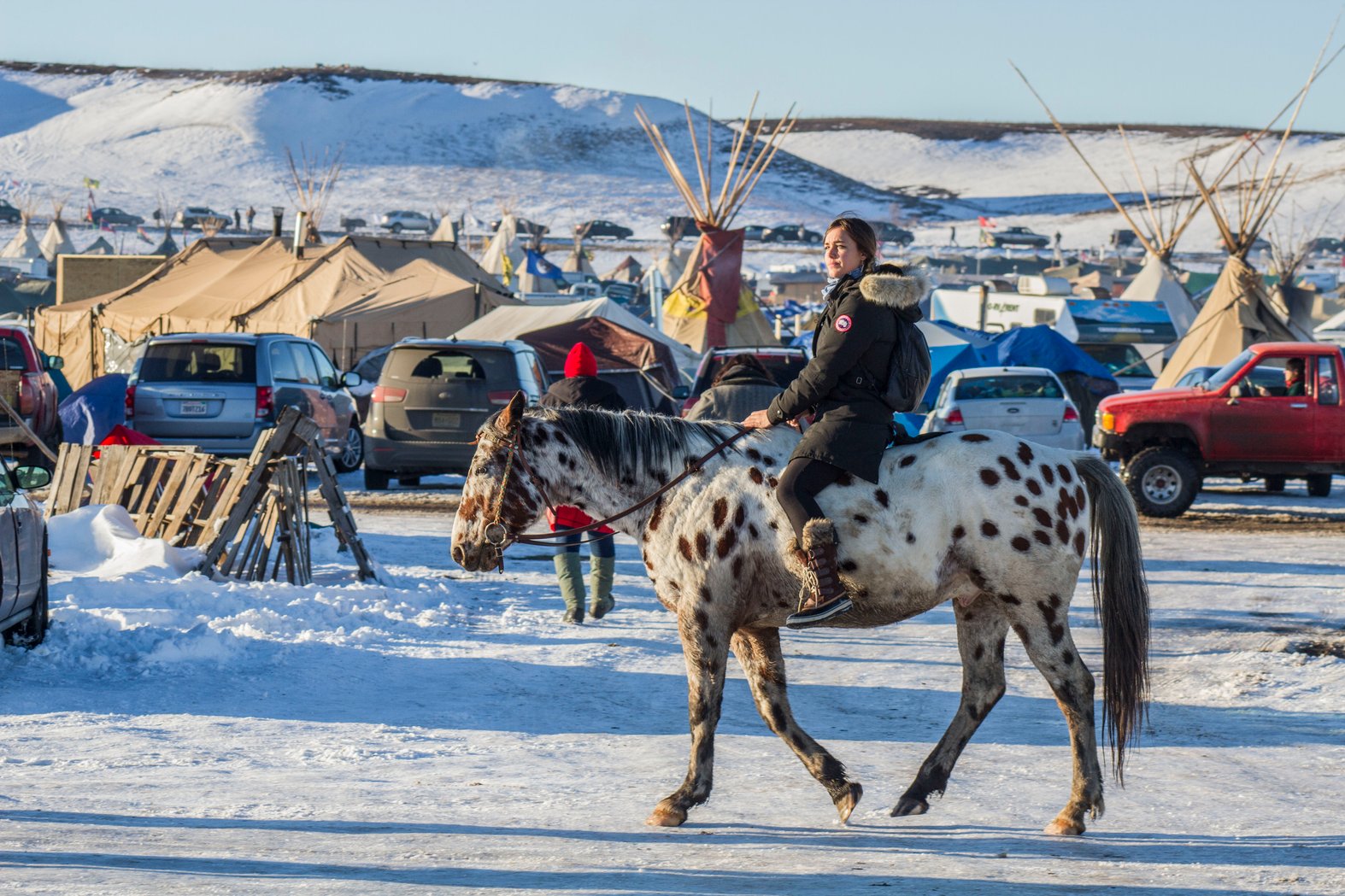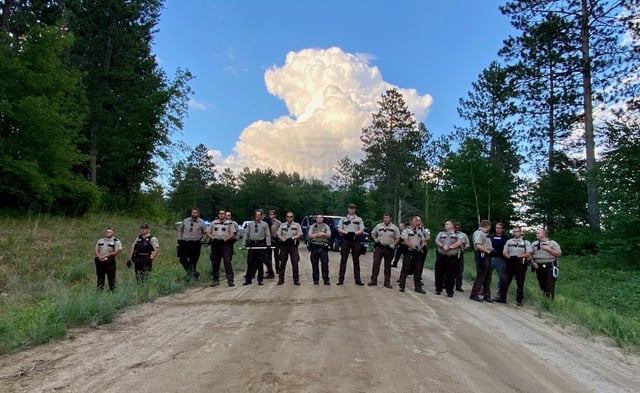
This month, the U.S. Army Corps of Engineers closes the comment period on its draft Environmental Impact Statement for the Dakota Access Pipeline, a 1,172-mile pipeline that’s been pumping 500,000 barrels of oil per day since May 2017.
Prefer to listen to this story? Check out the podcast episode here:
The pipeline runs from the Bakken oil fields in North Dakota to southern Illinois, crossing the Missouri and Mississippi Rivers. Over the past six years, every court in the country has ruled that the Army Corps of Engineers did not study the pipeline’s environmental impact closely enough before approving the pipeline’s route. The Standing Rock Sioux tribe has maintained all along that the project poses a serious threat to its drinking water. From April 2016 to February 2017 thousands of water protectors from all over the country (and beyond) joined them in protests and direct actions. The resistance at Standing Rock is often cited by the fossil fuel industry, police and politicians as the reason states need new anti-protest laws, while the backlash to that resistance is often cited by water protectors as the reason for PTSD, asthma, and permanent injuries.
Now, the Army Corps of Engineers says that removing the pipeline would be too damaging to the Missouri River and its surrounding ecosystems. The removal actions it describes in its EIS are the same actions taken to install the pipeline in the first place. The Army Corps suggests that removing the pipeline would be more environmentally harmful than allowing the oil to continue pumping under one of Standing Rock's primary drinking water sources. Nonetheless, this report—seven years late—represents one of the few pathways left to stop the pipeline.
The EIS says that a major spill under the Missouri River is remote to unlikely. As for climate change, this document claims that allowing the pipeline to continue operating as it is would, “ not generate any direct greenhouse gas emissions, with the exception of a minor amount of emissions associated with pipeline maintenance activities.”
That's because the Army Corps is only taking into account the emissions generated by the pipeline itself, not by the activity it enables: burning fossil fuels.
Finally, it claims there are simply no historic properties, like sacred sites, for example, in the area being studied.
A couple of nights before the hearing, I sat down with Honorata Defender, a journalist for the local Corson Sioux County News Messenger and her brother Jonathan Edwards, a former paramedic, to talk about the EIS. Edwards and Defender had organized some of the first grassroots meetings about the pipeline, held in an unheated movie theater in the reservation town of McLaughlin, South Dakota.
We ate pizza at a Cenex gas station with a small table in the back.
“It’s bulldoody. It's severely lacking in everything. It is not a real environmental impact statement,” Defender said of the EIS.
“I'm on the spill response team, so I did some hazmat classes a couple years ago, and um, Yeah, we're screwed here if there's an oil spill,” Edwards said.
The EIS doesn’t mention another kind of impact: the emotional and physical trauma of police repression. The pipeline company and its private security contractor TigerSwan worked with police to suppress the movement, using tactics ranging from aerial surveillance to infiltration to violence. It caused not only trauma, but also deep rifts within the community. Those kinds of long-term impacts are common around the world when corporations and governments forced through large polluting projects, and they typically go unacknowledged by regulatory processes.
“I know a number of people that's, you know, they have PTSD still, that suffer from PTSD still from, from what they went through because of how TigerSwan and the police handled everything,” Defender said.
“I'm in a group that's most likely to be killed by police,” Edwards said. “Native American males, you know, more so than African American males. So, um, I think it's just something that you expect, personally, that I expected, and um, It's just normal, I guess, unfortunately.”
“They gassed us, shot at us, um, beat people, you know, pointing loaded weapons at unarmed women and children, um, a lot of tear gas,” he added. “I have asthma now. I've never had any breathing problems before, before I went out there. But yeah, there's just a lot of tear gas, and mind you, for standing on our own land.”
“These people, I mean, they're gonna be haunted for the rest of their days,” Defender said. “We're all gonna be haunted for the rest of our days on, on the travesties that were committed there.”
Although the Standing Rock Sioux Tribe’s proposal is that the pipeline be capped, but left where it is, some water protectors, like Defender, would like to see it removed entirely.
“They say that it would be worse,” she said. “That's what they say throughout the whole environmental impact statement basically is that it'd be worse for the wildlife, it'd be worse for the habitat, it'd be worse for the fish to remove the pipeline, and I believe that's so false, that's the untruthiest thing I've ever heard. I mean, they already disrupted all of this by putting it in. So, why is it now a big deal to remove it?” .
Since the pipeline is already built, the EIS is backward. It describes the severe environmental harms that would come from removing the pipeline, which one has to assume are basically the same harms that would have come from putting the thing in.
The Standing Rock Sioux Tribe has already dropped out as a cooperating agency on the EIS.
“When this pre draft came out, it showed on the cover of this book that we were a cooperating agency with our logo. And when you open it up, you're like, hey, don't, you're not giving us anything. You're redacting everything. How is this cooperating? I don't want our logo on this document. I'm not supporting this document,” Standing Rock Tribal Chair Janet Alkire explained.
The pages on spill response in the EIS are heavily redacted. Alkire and others suspect it has to do with the independent contractor that drafted much of the EIS.
“When this came down in 2020, the tribes asked, ‘since we're in a cooperating agency, are you going to allow us to have some kind of say in who this independent company is going to be?’”she said. But months later, with little fanfare, Army Corps announced that they'd hired Environmental Resources Management. Environmental Resources Management has been accused of conflicts of interest before, including when it was hired by the State Department to help draft the EIS for the controversial Keystone XL tar sands oil pipeline in 2012.
Reporters and environmental organizations uncovered that some of the ERM experts who worked on the EIS had previously worked for the pipeline's parent company, TransCanada, and for other companies with a stake in KXL'S construction.
There were so many red flags, in fact, that the State Department's Office of Inspector General investigated. Ultimately, they concluded that none of it amounted to a violation of the Department's Conflict of Interest policy.
To many critics, that was just an indication of how truly broken the system was.
Environmental Resources Management again came under fire in 2018, when another government agency, the Federal Energy Regulatory Commission, hired the company to monitor construction of Enbridge's Atlantic Bridge Natural Gas Project. Records obtained by DeSmog showed the agency was aware that Environmental Resources Management had a business relationship with Enbridge, but hired them anyway.
Environmental Resources Management is a member of the American Petroleum Institute, which has long been an ardent supporter of the pipeline.
It's also a member of the American Fuel and Petrochemical Manufacturers, an industry association that helped draft new anti protest laws, which swept the nation in the wake of the pipeline protests near the Standing Rock Reservation in 2016 and 2017.
“We knew there was a conflict of interest,” Alkire said. “We all know what a conflict of interest is, you know. But we were just disregarded in that decision.”

A water protector at Standing Rock in the winter of 2016. Photo credit: Dark Sevier
Alkine said the tribe’s preferred option for DAPL is to seal the pipeline off, but leave it in the riverbed. “We chose that option basically not to destroy the riverbed.”
As the November 2023 hearing on the EIS kicked off, the Army Corps laid out the possible outcomes of this process. After the comment period closes on December 13th, the agency will have to decide again whether it's going to sign off on the pipeline's route, known as an easement, under the Missouri River.
It has five options: to not grant the easement, which would result in restoration, meaning that the existing pipeline would be stopped and dug up; to not grant the easement, but leave that pipeline in place so that the oil would stop, but there would be no excavation of the pipeline; to reissue the easement with the existing conditions; to grant the easement with additional mitigation measures; or to look at an alternative that reroutes the pipeline.
The hearing was dominated by water protectors from Standing Rock and other neighboring tribes, but there was also a duo of police officers, a handful of men who later told me they were pipeliners, and a few guys who didn’t quite look like they fit in. One later told me they were local law enforcement.
Rather than accepting comments publicly, the Army Corps asked that comments be submitted privately to stenographers sitting behind curtained booths. Water protectors who had hoped to deliver their remarks directly to the pipeline executives who built the project brought a bullhorn.
“We're not being given a mic, which, that's okay, we'll bring our own,” Floris White Bull said. “And when you're able to push people behind curtains, there's no accountability. And our voices lose their power when we're here in numbers. There's people here, and we're here wanting to talk.”
The Army Corps attempted to respond to the complaints. The next day, commenters had the option to either go into the booths or deliver their testimony by microphone. Tim Donaghy, the research manager for Greenpeace USA, took to it to comment on the lack of engagement on the pipeline’s climate impact in the EIS.
“Oftentimes in environmental impact statements, they'll say essentially, if we're not going to drill the oil here, it'll come from somewhere else. So it'll just be perfectly substituted. And because of that assumption, they say, Well, there's no climate impact from approving this project or disapproving it because it's going to be the same no matter what,” he said. “That flies in the face of what the science has shown about oil markets, which is that there's not going to be 100% new oil coming on, but it's not going to be 0 percent either it's going to be kind of somewhere in the middle. A lot of studies have shown that it's roughly around 50 percent of the oil will be replaced. But that means that building a pipeline like Dakota access is going to boost the oil supply, it's going to boost oil consumption, and as a result it's going to increase global greenhouse gas emissions.”
Julie Fedorchak, a member of the North Dakota Public Service Commission, which issued another key permit for the pipeline, says at the state level, they’re explicitly prohibited from considering such things when deciding whether or not to issue a pipeline permit.
“We had three public hearings, actually four if you consider the one for optimization and had a very exhaustive review looking at all of the impacts to the environmental impacts, all the river crossings, all the water bodies, wetlands, cultural resources, and unstable areas, like the whole gamut, so I think that, you know, all of those reviews were done effectively, and that's what the law requires. And so we need to support the law,” Fedorchak, a reliable advocate for the oil and gas industry, said.
Although federal agencies like the Army Corps are required by law to consider climate impacts, state laws vary significantly. In the case of the Dakota Access Pipeline, neither state nor federal environmental regulatory processes have ever fully accounted for the climate impacts of the Dakota Access Pipeline.
The hearing was winding down when Standing Rock tribal member Waniya Locke got up to speak
“One of the things that hurt me personally, that affects me to this day, is when I saw the announcement from the local media that the Army Corps of Engineers hired on private security,” she said. “According to the TigerSwan documents, in 2016 we were listed as a jihadist terrorist. They used aerial to monitor us. There was chemicals that were sprayed upon us. And they activated specific propaganda that was put out on a national level.We were brutalized out there and then we were lied about.And then I watched friends, family. I even watched our then tribal chairman Dave Archambault get arrested.”
Later, in the hallway, Locke added that prior to Standing Rock she had only experienced historical, generational trauma, passed down by ancestors who had been sent off to Indian Boarding Schools or involved in the Dakota Wars.
“In 2016, I actually got to live through warfare,” she said. “Because North Dakota, the Army Corps of Engineers, the Obama administration, Trump administration, Biden administration continue to allow Dakota Access Pipeline to be built and operating illegally right now. And how it was built was by using warfare tactics on innocent people that were telling the truth.”
Locke’s experience aligns with what psychologists predicted would happen. In October 2017, the Society of Indian Psychologists, which exists to support the psychological well-being of American Indians, put out a statement about police and private security's actions at Standing Rock. put out a statement about police and private security's actions at Standing Rock.
The statement said, “Civilians in the movement would likely have developed normative paranoia and fear relative to these increasing stressors placed on them over time. It would be likely that those who remained at the camps over long periods of time could begin to question who could be trusted or communicated with, and develop ruminations and recurring thoughts regarding their safety.”
They also noted, “Given that we know a great number of Native American people participated in the movement, and that multi generational trauma and the ongoing effects of colonialism have left their mark, it is likely to have triggered normative fear and recurrence of traumatic themes from history.”
Steve Wolf, public information officer for the Army Corps of Engineers, said they did not bring in private security for the EIS hearing.
“I mean, you see uniformed police officers here,” he said. “This is a private property. I think people have seen what has happened in the past with this project, and I would certainly imagine they're a bit concerned. If you had a private enterprise, would you be concerned?”
When I followed up via email to clarify, Wolf’s response was vague. “When we approach private sector organizations such as a hotel to conduct a public meeting, we cannot simply dictate to them how their facility might be used for this purpose,” he wrote. “Ultimately, the U. S. Army Corps of Engineers must agree to and pay for the requirements of a given facility to host a public function for our environmental analysis process.”
“What you witnessed firsthand is that no law enforcement action was taken against anyone expressing their views or attendance at these two public meetings,” he added. “Freedom of assembly and freedom of expression were alive and well at these meetings.”
Regardless of the outcome of the EIS process, water protectors who are on the ground will continue to carry the weight of what happened at Standing Rock.
“It was really upsetting to stand there and watch the people that are in uniform, some of whom I used to work alongside up in Bismarck, and they're there shooting at you, and they're shooting tear gas and rubber bullets, it’s just upsetting,” Edwards said. “But I don't necessarily want to focus on that too much on a daily basis because I mean, you can't walk around pissed off all day. So, I just kind of had to let some of that go. I'm still working on that. I assume that'll be a lifelong process for me because they hurt a lot of people out there. I don't really follow what the government does anymore. I just... I just don't have any faith in them at all.”
For his sister, Honorata Defender, there’s one silver lining to all of it. “It was a very big boom. And the sound waves can still be felt all across the world because people realize that, you know, they matter. Their voice matters and with that voice they can do things. Remarkable things. Extraordinary things.”






